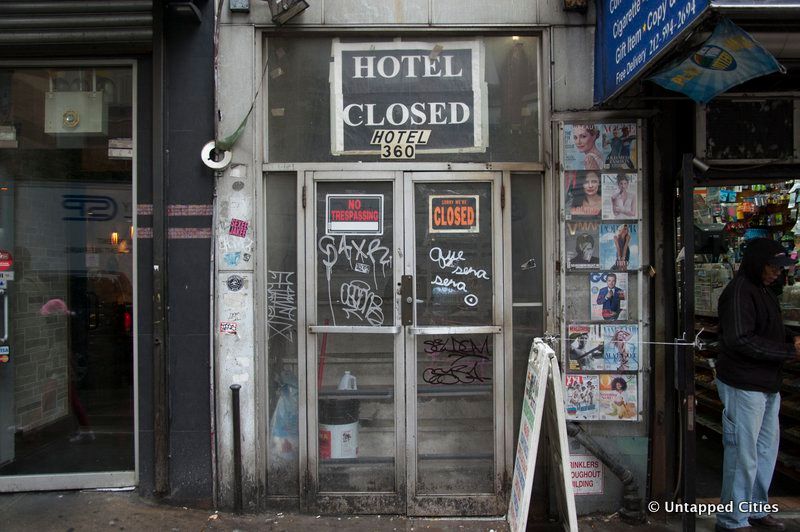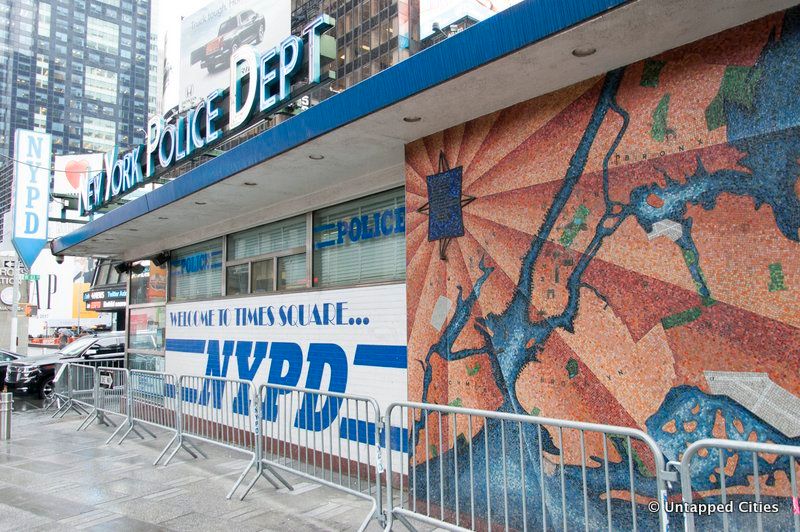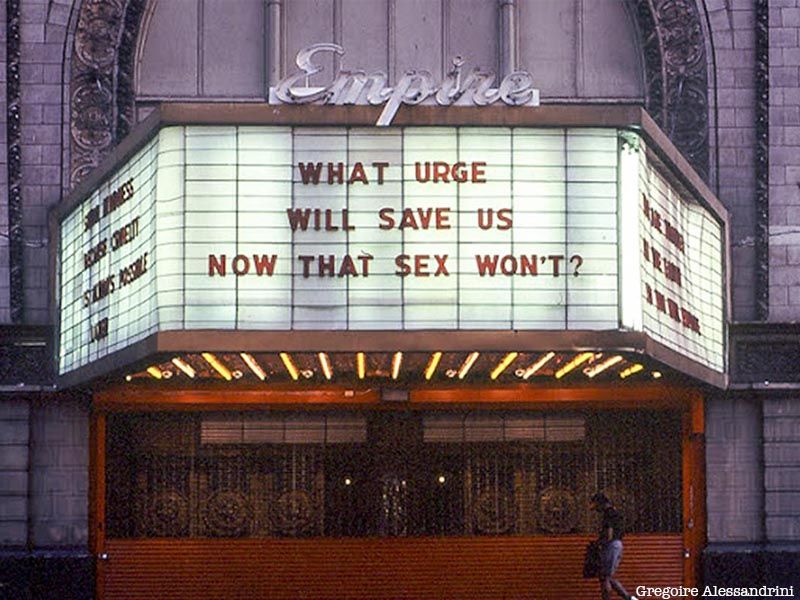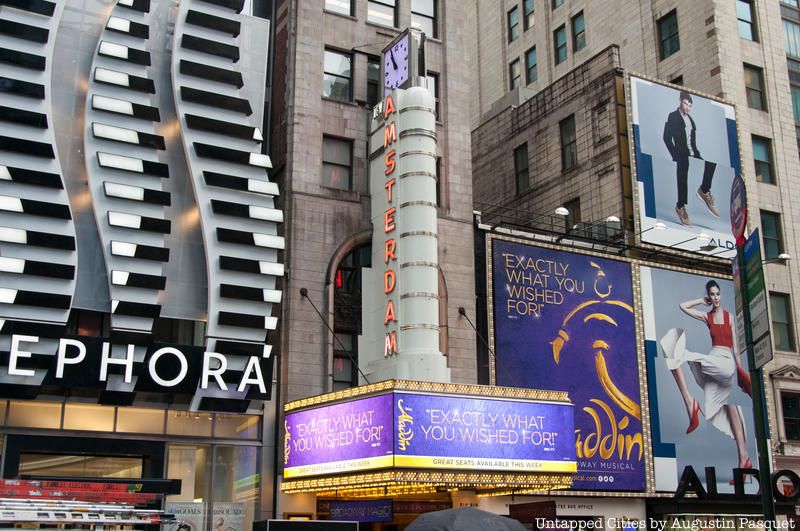How to See the Liberty Bell...in Queens
A copy of the famous American bell can be found inside a bank, which itself is modeled after Independence Hall!



While some New Yorkers may still avoid walking through Times Square, it’s for drastically different reasons than why many avoided the area in the 1970s. The thriving theater district of New York City experienced a steady decline from the Great Depression to an all-time low in the 1970s. It was during this time that 42nd Street became known as “The Deuce.” Eighth Avenue was called the Minnesota Strip (due to the high volume of prostitutes who walked it) and Times Square was New York’s red light district, a seedy mecca of porn shops, peep shows, drugs, crime, and hot sheet hotels. This era of Times Square has been depicted in HBO’s series The Deuce.
In the 1980s, work began to transform Times Square into the flashy and comparably wholesome retail and entertainment destination it is today. But some New Yorkers are nostalgic for the days before Times Square became “Disney-fied” and lucky for those people, there are still remnants of Times Square’s sordid past hiding in the shadows of today’s blinking signs and giant LED screens. From a children’s theater that used to be an XXX-porn house to a police station in a smut shop, check out 10 remnants of gritty old Times Square you can still see today.
You can explore the remnants of this lost Times Square on our upcoming walking tour!

The Elk Hotel was one of Times Square’s last pay-by-the-hour hotels. The hotel offered single rooms for $40 per night ($45 for a double) and hourly rentals as low as $5 per hour. In line with the low rates, amenities were sparse. There were no televisions, phones, or air-conditioning, and bathrooms were communal (two per floor).
In the early 20th century, the hotel was owned by an Irish family and served as the first home to many immigrants who came through Ellis Island. Many hot sheet hotels would pop up in the Times Square district throughout the century, though the Elk would be one of the few able to skirt redevelopment. Other hotels, including the Evans on West 38th Street and the Woodstock on 43rd, have since been demolished or remodeled. Today, the fate of the Elk Hotel is unknown as it stands locked and graffitied on 42nd Street.

The Times Square Police Station has inhabited multiple buildings over the decades and each has had a storied past. Before the police moved in here in 1993 the short building served as a Times Square Information Center. The Information Center opened in 1957 and featured an artistic mosaic map of New York City on either side. These mosaics, designed by artist Edward Meshekoff, still adorn the station today.
But the police’s first Times Square location has a seedier backstory. Prior to 1993, the station was located at 1465 Broadway and 42nd Street, the former location of Crossroads Bookstore, once one of the largest pornography stores and peep shows in the city. The store was open 24-hours and featured picture books and 72 movie machines which continuously played adult films. The smut-shop was eventually acquired by the 42nd Street Redevelopment Corporation in 1976 and today is home to a bevy of retail shops.

While once Times Square was filled with places like The Playpen, a sex emporium selling porn and sex toys and offering live peep shows, it is now a rarity. The store is one of less than ten sex shops remaining in the district. Many adult entertainment shops were closed down in the 1990s due to strict regulations enforced by Mayor Giuliani to clean up the area. Sex-related businesses couldn’t operate within 500 feet of residences, schools, places of worship or other sex-related businesses. Later, the rules were loosened and stores with at least 60 percent non-X-rated merchandise were not technically considered adult entertainment businesses.
The Playpen in NYC was originally located inside a theater at 693 8th Avenue. The theater opened in 1916 as the Ideal Theater and was known by a series of names after that including The Cameo, Squire Theater, and The Adonis. The store was connected to The Funny Store, a gag gift and magic shop which helped the Playpen NYC comply with the 60/40 rule. The Playpen moved a few doors down to its current location, on Eighth Avenue between 43rd and 44th Streets, in 2007 when the theater was demolished. Today, the former site of the theater is a Shake Shack.

Now a theater for children, the New Victory was once the only XXX-porn house on the block. Built in 1900 as the Republic Theatre and opened by Oscar Hammerstein I, the New Victory is among the oldest theaters in Times Square. The saucy programming began in the 1930s when the theatre was transformed into Broadway’s first burlesque house, Minsky’s Burlesque.
Burlesque was banned by Mayor LaGuardia in 1941 forcing the theater to turn to showing movies. It changed its name to The Victory in the spirit of World War II. In the 1970s, the theater became the first in the area to start showing porn. More firsts for the theater include that it was the first to be redeveloped by The New 42nd Street organization and became the city’s first nonprofit theater programmed for youth. In 2018, in a moment of history coming full circle, the theater hosted a screening of Against All Odds: Transforming 42nd Street, a documentary about 42nd Street’s redevelopment.

In 2018, Times Square lost a stalwart of its gritty past, once known as “The McDonalds of Sex,” the infamous Show World Center. Show World Center opened in 1977 and at 22,000-square-feet it was the largest store of its kind in New York City. The merchandise and services offered included X-rated films, peepshows, adult books, live sex acts, and in-store appearances by famous porn stars. The operation was run by owner Richard Basciano, “The King of Porn,” who lived in a luxury penthouse on the top three floors of his store. Basciano was the leader of the Coalition for Free Expression, a group of adult-entertainment business owners who fought the efforts of the redevelopment of 42nd street and the laws that impeded on their businesses.
Over the years, Show World Center slowly began to shrink. Parts of the building were rented out space to theatrical productions and the 60/40 rule forced Basciano to sell things like kung-fu tapes and New York themed souvenirs. When Basciano died in 2017, his family closed the business. In its place now is a new retail and office space.

If you went looking for The Empire Theater in the spot where it was in the 1970s, you wouldn’t find it. Not because it has been demolished, but because it has been moved. Opened in 1913 and designed by renowned theater architect Thomas Lamb, the theater was lifted up and rolled 168 feet from its original location in the late 1990s. As one of the jewels of the 42nd street redevelopment project, the theater maintains many original architectural features including the exterior facade and many interior details. Now a 25-screen AMC multiplex, you will find architectural elements of the theater inside the lobby.
The theater was originally converted to screen movies in 1942. The Empire was among many theaters in Times Square, including the Times Square Theater and The Lyric, which operated as grindhouses in the 1970s and 1980s. At that time, movie-going in the area was a risky activity. Pickpockets and muggers lurked in the dark and drug deals were happening in the balconies. Physically, the theaters were in poor condition with sticky floors and seats in disrepair.

The Holy Cross Church on 42nd Street between Eighth and Ninth Avenues has borne witness to all of the depravities of Times Square through the decades and has stood as a place of respite from the surrounding debauchery. The church was built in 1868 and is the oldest structure on 42nd Street. It is most famously associated with Reverend Francis P. Duffy and sometimes referred to as Father Duffy’s Church, though many of the churches pastors have been active in the efforts to clean up the neighborhood. The church posed a threat to many establishments, including Show World Center, when Giuliani’s 500 feet rule was proposed.
In addition to being the pastor of Holy Cross Church, Father Duffy is most well known for his position as chaplain of the 69th Infantry Regiment of the New York National Guard, aka the “Fighting Irish.” After World War I, where the regiment fought on the front lines in France, Duffy became pastor of the Hells Kitchen congregation. The neighborhood was a hotbed for corruption and gang activity since the 19th century. The nearby Duffy Square, which features a statue of Duffy looming over the red stairs of the TKTS booth, is also named for this famous figure.

The New Amsterdam Theater is the birthplace of the famous Ziegfeld Follies and an example of how much Times Square has changed. Hit hard by the Great Depression, in 1937 the theater was converted to screen movies. The quality of entertainment gradually fell and by the 1960s and 1970s the theater was showing genre films and low-budget flicks. The theater was eventually abandoned in the 1980s.
In 1992, as part of the 42nd Street redevelopment project, New York City bought the theater. It was then acquired by the Walt Disney Company. Bringing in the renowned family friendly brand with a squeaky clean image was a major catalyst in turning the tide of 42nd Street, but the transition wasn’t easy. Before the purchase, the Disney company made a series of demands which greatly affected the rest of 42nd Street’s development and exerted its influence on the design and operations of other business that were coming to the block. In 1997 the Lion King debuted at the New Amsterdam and the theater has continued to show stage productions of Disney’s most beloved family films.

Located across from Port Authority, the Kaufman Army and Navy military surplus store has been around since 1946. The store is full of a variety surplus and new military items as well as civilian gear manufactured by military contractors. It is run by the passionate second generation owner Jim Korn, who took over in 1984 for his grandfather Nathan Kaufman, the founder of the store.
Kaufman Army and Navy’s first location was at Cortlandt and Greenwich Streets in lower Manhattan, a site that was eventually demolished to make way for the World Trade Center. It moved to 42nd Street in 1940 and after a small move down the block, has been there ever since, flanked by two U.S. Army circa 1898 Hotchkiss mountain cannons. The store holds the title of the oldest business in continuous operation on West 42nd Street.

In a book about New York City in 1975, The Man Who Saved New York: Hugh Carey and the Great Fiscal Crisis of 1975, the authors describe Port Authority Bus Terminal as “a cavern of squalor that the destitute, the mentally disturbed, and the drugged and inebriated called ‘home.'” Opened in 1950, and originally heralded as an improvement to bus transportation in New York City, its reputation quickly went south.
The terminal was expanded to 42nd Street with an annex in the 1970s. The design of building alone has earned it a spot on many a list of most hated and most ugly buildings. Port Authority Bus Terminal was enveloped in the crime and vice of the surrounding area and became a dangerous place to be. Plans are underway currently to replace the terminal with a new structure, but it is in the very early stages at this time.
Next, check out 10 Secrets of Times Square and 10 Oldest Broadway Theaters in Times Square
Subscribe to our newsletter